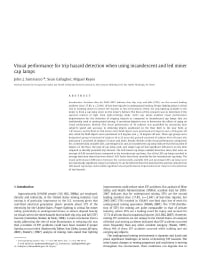Mining Publication: Visual Performance for Trip Hazard Detection When Using Incandescent and LED Miner Cap Lamps
Original creation date: April 2010
Authors: JJ Sammarco, S Gallagher, MA Reyes
Accident data for 2003-2007 indicate that slip, trip, and falls (STFs) are the second leading accident class of lost-time injuries in underground mining. Proper lighting plays a critical role in enabling miners to detect STF hazards in this environment. Often, the only lighting available to the miner is from a cap lamp worn on the miner's helmet. The focus of this NIOSH research was to determine if the spectral content of light from light-emitting diode (LED) cap lamps enabled visual performance improvements for the detection of tripping hazards as compared to incandescent cap lamps that are traditionally used in underground mining. A secondary objective was to determine the effects of aging on visual performance.
